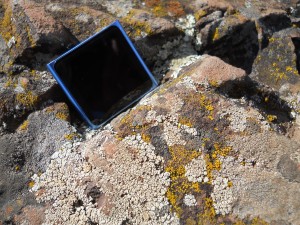Recreati wouldn’t normally review consumer electronics, but we’re making an exception for the new Apple iPod Nano. (Close readers will note that we’re capitalizing Nano even though Apple doesn’t. In English, the proper name of a thing is capitalized. We’ll bend on the intra-capitalization of iPod, but we have a limit.)
Back to business: we’re making an exception for the Nano because it’s been promoted specifically as a fitness device. And it sure looks and feels like it is. It’s nearly weightless, which is handy if you’re going for a run. It clips to your shorts or shirt, so you don’t need to slip that bulky old iPod Touch into an arm band that makes you look like a futuristic funeral usher (or, much worse, put it into the pocket of your baggy running shorts where it swings and sways and pummels your thighs). (Also, you aren’t tempted to set it on the treadmill where it invariably gets knocked or vibrated until it falls on the running surface, bounces around your ankles and then gets shot noisily at the person on the machine behind you.)
If you like to listen to a game as you run around a lake, or lope along on a treadmill while you watch TV at a club, a radio is a necessity. The Nano comes with a true FM radio, rather than the radio station apps available for the Touch. This is key because you need wi-fi connectivity for the app to work, and you don’t get that running in the woods or in many clubs.
The big upgrade with this model is that it’s been tricked out with a pedometer that tracks your distance and time (using height and weight data that you enter), calculates the calories you’ve burned and records each workout session. Earlier versions of the Nano required the purchase of a Nike+ sensor for your shoes and a transmitter for your Nano. You can still opt to upload all your data to the Nike+ web site whenever you sync your iPod; this gives you the ability to track, set goals and compete with others.
There are also add-ons, like a heart rate monitor.
Back to the barebones features: the music, the radio and the pedometer. Do they work?
Yes. The music on this miniscule device—and the ease of use—is as good as any other iPod. The radio also performs admirably, pulling in a strong signal even at our club, where inexpensive FM radios seem to buzz with static.
The pedometer isn’t as accurate as a GPS-equipped device (see below) but it provides an approximation of what you’ve accomplished on your hike or run. We conducted two field tests, one on a treadmill and the other on a 6.8-mile stretch of the Superior Hiking Trail. We expected the trail test to over-estimate the distance (because strides are shorter scrambling up or down the steep sections) and we were right: the Nano claimed 8.1 miles. On the treadmill, doing half-hour walks at a couple of different speeds, the Nano underestimated our distance (by around 10 percent), so either the treadmill is inflating our accomplishments or the stride algorithm is off. (We were tempted to take it to the local track for a definite answer on that, but at some point this begins to feel obsessive. And we don’t care that much.)
Just as we were preparing to post this review, Motorola announced its MotoACTV device, which looks like an Android-powered Nano with the same focus on the fitness market. We didn’t take this one out for a test (it doesn’t hit the stores until November 6), but Motorola’s marketing literature identifies some obvious commonalities, like the ability to play music, track distances, and upload results to a web site. There’s also an FM radio, and the same disregard for the rules of capitalization.
There are also big differences: the MotoACTV is a bit clunkier, but it also embodies some serious tech upgrades over the Nano. It has built-in GPS capability, so you get a very solid estimate of your (off-treadmill) distances. It can also be mounted on your bike. It will come with wired headphones, but you can also buy a wireless model with a sensor that tracks your heart rate through your ears. It has Bluetooth capability so you can use it to answer your phone (but that requires that you carry your phone, which defeats the purpose of a tiny music-radio-fitness device). It also has ANT+ capability that lets it synch up with heart rate monitors and other fitness devices. And it tracks your performance while you’re listening to specific songs, so it knows that you pick up your pace when a James Brown song plays. It remembers your high-performance songs and can assemble them into a playlist.
Another huge difference is the price. The 8 GB Nano starts at $129. The 8 GB MotoACTV costs $250, with wired headphones that can take and make calls. It costs another $100 to get the cool heart-rate monitor headphones. Is it worth it? That’s a personal question. But the high price does open other choices: for less than the cost of the MotoACTV and the cool headphones, you could buy a Nano and any of a long line of fitness devices—some with GPS, some with heart rate monitors, some that are waterproof. You could pair that device with the Nano when you’re on the on the trail or use it alone in a pool or lake. So more flexibility, although you’re using two devices.
And we can’t vouch for the MotoACTV’s performance. No one can until November 6. So we’re going on marketing literature. Based on that, it’s pretty sweet. For a pretty penny.
Photos by Virginia Kearney











